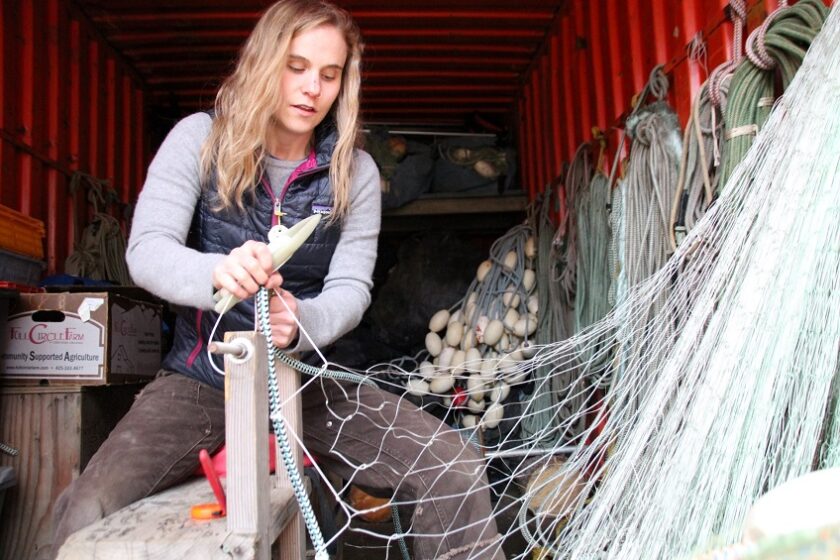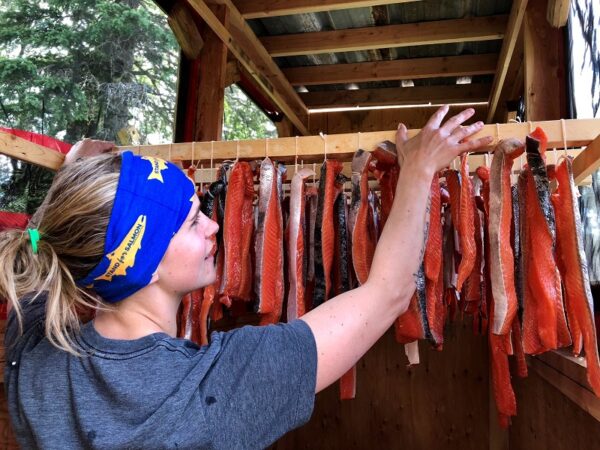
Fisherman Susie Brito is Alaska born and bred. She talks to us about life in Bristol Bay – home to the largest wild, sustainable, and well-managed commercial sockeye salmon fishery in the world. It’s an intense, seasonal existence – but Susie loves the people and the challenge of providing for her family from the land and the sea.
What is your job title and what does the role entail?
I am a commercial fisherman, net hanger, subsistence fisherman and business partner as well as being a practicing Registered Nurse, freelance writer and food blogger producing ‘Set the Net’ – a blog on food and life in Alaska’s Bristol Bay.
In rural Alaska, to be successful, one must wear many hats. My husband and I own and operate a 32-foot drift gillnet commercial salmon fishing vessel in Bristol Bay where the season, though short, is an intense grind that occupies nearly all our time from June through to August.
Before we had children, I would spend full seasons on the boat fishing. Now, with young ones at home, I build the nets we use to fish with. I am also responsible for logistics, hiring and managing crew, finances, and shore support while the boat is on the water.
Our subsistence lifestyle leads me to catch and process all the salmon our family will eat for the year.
How did you get involved in this industry?
I was born and raised in Alaska, sport fishing, camping and dog mushing in the Matanuksa Valley. When a summer job with the Alaska Department of Fish and Game landed me in Bristol Bay over 10 years ago, my true love affair with salmon began. Soon tallying and counting fish from the enormous commercial fishery wasn’t enough for me—I wanted to be on the deck upon the waves, and somewhere in this quest I met my husband Bronson. Ten years, ten cycles of salmon later, we still manage to keep an even keel in our lives, on and off the water.
What is life like as a fisherman in rural Alaska?
 Fishing defines us, it pervades our meals, thoughts and actions. We time our lives around the season.
Fishing defines us, it pervades our meals, thoughts and actions. We time our lives around the season.
We set our calendar by when we will begin hanging nets for our drift boat, driving pegs for our subsistence site, setting lines, greeting crew who will help get the boat ready, and catching the first king salmon of the summer. Then we launch the boat, work the first sockeye salmon commercial opener, celebrate the peak of the season, catch enough salmon to focus efforts on other foraging and subsistence activities, and haul the boat out. Finally, our crew leaves town, settlement checks for deliveries arrive, the next season’s ADF&G Forecast comes out. We order web for our gill nets, attend the industry Fish Expo, price adjustments come, our freezer empties. The year begins anew.
What do you love about it?
More than the act of fishing, it is the people in rural Alaska who are generous with their time and resources that make me love it here. They have taught me to hang gear; to can, salt and make traditional strips from salmon; and how to run my subsistence site. When someone gets a few extra kings and your net pulls up short, they share their bounty unerringly.
I have loved food and cooking for as long as I can remember. Commanding the kitchen, teaching people about uses for local foods and offering innovative ways to use things they already have on hand is inspiring to me. Life in rural Alaska dictates planning ahead, filling our freezers and shelfs when food is available. We eat mainly meat from our subsistence activities – salmon, halibut, moose, caribou, ptarmigan, and spruce grouse. We also pick berries, greens, and other wild plants that we preserve in various ways. I love giving others ideas how to use these resources, or encourage them to reduce waste by consuming more of the food we harvest. I also love encouraging others to support the small businesses around them, buying local, knowing your fishermen, and sourcing from well managed sustainable fisheries.
What do you find challenging?
The commercial fishery is entirely consuming. Our boat will leave the harbour and not return for weeks on end. The work is unlike anything I can compare it to. Imagine being exhausted, hungry because you are too tired to cook, near the limit of your capacity and then pushing yourself harder to make another set, pick another load, and sleep later. It weighs on our family but there is a certain joy and excitement that comes with this life that is unparalleled.
In addition to commercial fishing, our subsistence lifestyle is intensely seasonal, with an ever-pervasive feeling of running out of time. It is about picking the greens when they are tender and new, catching the halibut when they move into the shelf for spring, harvesting salmon and putting them up in all the ways your family loves, picking berries before the frost, shifting attention to hunkering in for winter to enjoy the stores our hard work has provided without forgetting that there is smelt to catch, rabbits to trap, and school to get the kids to.
Where do you see yourself in 5 years’ time?
In 5 years, my husband and I intend to have two fishing boats in the Bay. I’ll captain our current boat on my own and he’ll be on a new boat, with our children on the water with us for much of the season, if possible.


